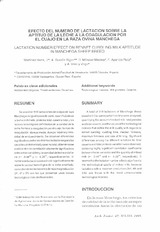Efecto del número de lactación sobre la aptitud de la leche a la coagulación por el cuajo en la raza ovina manchega
Lactation number effect on rennet curdling milk aptitude in manchega sheep breed
Autor
Garzón Sigler, A.
Aparicio Ruiz, F.
Vera y Vega, A.
Méndez Medina, D.
Martínez Hens, J.
Editor
Universidad de Córdoba, Servicio de PublicacionesFecha
1993Materia
CaseínasProteínas lácteas
Lactación
Ganado ovino
METS:
Mostrar el registro METSPREMIS:
Mostrar el registro PREMISMetadatos
Mostrar el registro completo del ítemResumen
A total of 918 lactations of Manchega sheep breed with the same parturition time were analysed, quantifying the amount of milked milk, total proteins and total caseins, and the values of the technological indexes that define the milk quality with regards to rennet curdling: curdling time, mediun firmness, maximun firmness and rate of firming. Significant differences among the different lactations for total caseins and total proteins variables were observed, obtaining highly significant correlation coefficients between these variables and the quantity of milked milk (r= -0.44°` and r= -0.26-, respectively). It seems that the lactation number affects significantly the technological quality of milked milk, because lactations with a maximun production (3rd, 4th and 5th) are those with the most unfavourable technological indexes. Se analizan 918 lactaciones de ovejas de raza Manchega de igual época de parto, cuantificándose la leche ordeñada, proteína total, caseína total y los índices tecnológicos definitorios de la calidad de la leche frente a la coagulación por el cuajo: tiempo de coagulación, dureza media, dureza máxima y velocidad de endurecimiento. Se observan diferencias significativas entre las distintas lactaciones para las variables proteína total y caseína total, obteniéndose coeficientes de correlación altamente significativos entre estas variables y la cantidad de leche ordeñada (r= -0.44°` y r= -0.26-, respectivamente). El número de lactación parece incidir significativamente sobre la calidad tecnológica de la leche ordeñada, coincidiendo las lactaciones de máxima producción (3•, 4• y 58) con las que presentan unos índices tecnológicos más desfavorables.

